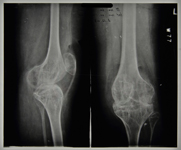|
Tuberculosis of the Knee
The knee is considered to be the third most likely site for tuberculosis of the bones and joints, following the spine and hip.
Tuberculosis of the knee is generally caused by haematogenous spread of infection from a primary source, most commonly the lungs. There are a number of stages the disease progresses through once infection has taken hold in the knee.
| • |
Normal - There may be synovitis or soft tissue swelling, with an increase in the amount of fluid within the joint. Swelling may include the epiphyses and a reduction in bone density in the affected area.
|
| • |
Osteomyelitic - Evidence of bone lesions or cysts across the epiphyses and metaphysis. No joint space narrowing.
|
| • |
Arthritis - Narrowing of joint space but no disorganisation of the joint and no bone destruction.
|
| • |
Arthritis - Destruction of bone surfaces involved due to demineralisation and erosion and gross disorganisation of the joint. Loss of movement highly likely.
|
In addition to the soft tissue swelling, further changes can include the presence of sinuses in the tissue surrounding the affected joint which may discharge pus. As radiographic anomalies will usually only appear after three to four weeks, initial soft tissue changes in addition to any pain in the joint are the first indications of infection.
It was noted amongst those admitted to Stannington with tuberculosis of the knee, that many had had some recent trauma affecting the knee in question, for example a fall whilst playing or a knock to the knee. Trauma can activate tuberculous disease that has been lying in dormancy.
|
|

Click Image to Enlarge
|